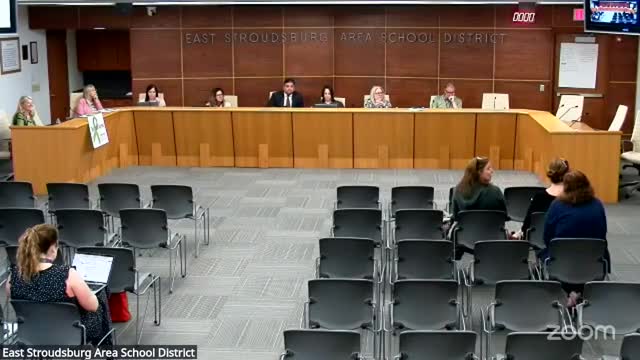Committee previews revamped world language curriculum emphasizing early AP-aligned skills and AI tools
May 03, 2025 | East Stroudsburg Area SD, School Districts, Pennsylvania
This article was created by AI summarizing key points discussed. AI makes mistakes, so for full details and context, please refer to the video of the full meeting. Please report any errors so we can fix them. Report an error »

A World Language committee presenter gave a first look May 1 at a rewritten world language curriculum that the committee said shifts instruction to a top-down, AP-exam-aligned model and integrates newer digital tools including AI-driven practice and family-facing online progress checks.
The presenter, identified in the meeting as Mrs. Matheson, told the East Stroudsburg Area School District committee she and colleagues began vetting vendors in spring 2024, sent materials to teachers for trial units in spring 2025, and have started writing and piloting levels 1–5. “This the things that are out there that are brand new are amazing,” Matheson said, adding that many current district texts are “over 25 years old.”
The presentation explained that publishers now design curricula by first identifying the six AP skill categories and then scaffolding backward so early-level students practice higher-order tasks earlier than previously expected. Materials Matheson described include online texts, audio and video, readers, workbooks and “AI components that were not available in our former work.” She said units include end-of-unit “I can” statements and student portfolios so parents can monitor progress online.
Matheson described an internal decision to separate intermediate (grades 6–8) and high school materials after finding publishers’ intermediate-level offerings often mirrored high-school content. She said intermediate teachers are re-evaluating options specifically for grades 6–8 while the high school work continues. Matheson said the review process included attending industry conferences (ACTFL) in fall 2024, collecting examination copies, and asking publishers to present and pilot units.
Committee members asked no substantive follow-up questions during the presentation. The committee did not vote on adoption during the May 1 session; Matheson framed the appearance as a “first look” and described subsequent steps for narrowing vendor choices and preparing a recommendation.
Why it matters: District presenters said the change aims to modernize instruction, align learning targets across grades, and give families clearer visibility into student progress. Materials described would replace decades-old texts and add technology-enabled practice, which the presenter and committee argued would better prepare students for advanced coursework.
Next steps: Matheson said the committee will continue pilots, finalize publisher selections and submit formal recommendations to the full board for approval at a later meeting.
The presenter, identified in the meeting as Mrs. Matheson, told the East Stroudsburg Area School District committee she and colleagues began vetting vendors in spring 2024, sent materials to teachers for trial units in spring 2025, and have started writing and piloting levels 1–5. “This the things that are out there that are brand new are amazing,” Matheson said, adding that many current district texts are “over 25 years old.”
The presentation explained that publishers now design curricula by first identifying the six AP skill categories and then scaffolding backward so early-level students practice higher-order tasks earlier than previously expected. Materials Matheson described include online texts, audio and video, readers, workbooks and “AI components that were not available in our former work.” She said units include end-of-unit “I can” statements and student portfolios so parents can monitor progress online.
Matheson described an internal decision to separate intermediate (grades 6–8) and high school materials after finding publishers’ intermediate-level offerings often mirrored high-school content. She said intermediate teachers are re-evaluating options specifically for grades 6–8 while the high school work continues. Matheson said the review process included attending industry conferences (ACTFL) in fall 2024, collecting examination copies, and asking publishers to present and pilot units.
Committee members asked no substantive follow-up questions during the presentation. The committee did not vote on adoption during the May 1 session; Matheson framed the appearance as a “first look” and described subsequent steps for narrowing vendor choices and preparing a recommendation.
Why it matters: District presenters said the change aims to modernize instruction, align learning targets across grades, and give families clearer visibility into student progress. Materials described would replace decades-old texts and add technology-enabled practice, which the presenter and committee argued would better prepare students for advanced coursework.
Next steps: Matheson said the committee will continue pilots, finalize publisher selections and submit formal recommendations to the full board for approval at a later meeting.
View full meeting
This article is based on a recent meeting—watch the full video and explore the complete transcript for deeper insights into the discussion.
View full meeting